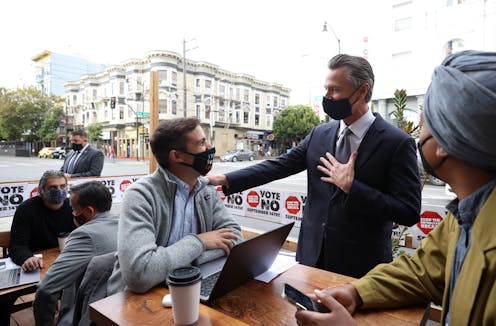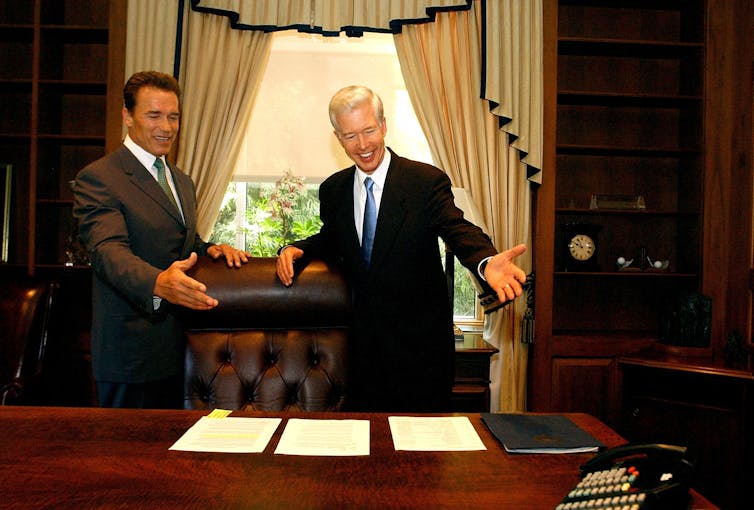California recall: There's a method to what looks like madness
It’s easy to make fun of California politics. But a longtime scholar of those politics says the attempt to recall Gov. Gavin Newsom is part of a long-running attempt to hold government accountable.

The California governor recall election has been yet another opportunity to portray California as a strange place with very odd practices.
And the recall truly has bizarre quirks that could, for example, produce a replacement governor with much less voter support than the incumbent governor – Gavin Newsom – facing recall. With 46 recall challengers vying for Newsom’s job and only a plurality required to win, it’s possible a winning candidate could become governor with far less than 50% of the vote.
But California’s direct democracy, which is being savaged by writers from within California – “Elections are supposed to represent the will, not the whim, of voters” says a (San Jose) Mercury News editorial – as well as from the usual suspects who are outside the state, reflects an important, even if flawed, vehicle to update America’s durable but staid democratic institutions.
Founders not keen on direct democracy
By the standards of the American republic founded in 1789, direct democracy is, much like California itself, a new kid on the block.
The founding doctrine of American government was a stable representative republic in which elected leaders would check and balance each other by their service in governing bodies that were formally separate, but with shared authority. In other words, the officeholders would hold their fellow officeholders accountable. This same plan forms the basis of all 50 state governments today.
The Founding Fathers hated any type of direct democracy and made their feelings known about it. “Nothing but a permanent body can check the imprudence of democracy,” wrote Alexander Hamilton. “Their turbulent and uncontrouling disposition requires checks.”
The Progressives of the late 1800s and early 1900s, however, thought that direct democracy was the essential solution to a problem the Constitution did not address: What if elected leaders were neither willing nor able to hold one another accountable?
In more contemporary terms, direct democracy also addresses cases in which the popular will is frustrated by the arcane, slow and even obstructive legislative process. Checks and balances can mean no progress at all.

Protecting the peoples’ needs
The Progressive movement enjoyed great popularity in the western and southwestern states that were not part of the original 13 states. It built on a deep suspicion that representative government could not protect the needs of the people because it could not resist the power of special interests.
In California, where the Progressives put down deep roots, reformers loathed the Southern Pacific Railroad, which managed to corrupt elected leaders all over the State Capitol. No matter how many elections could be won by well-intended candidates for state assembly or state senate, the railroad would still dominate.
To the Progressives, the solution was to vest some legislative power directly in the hands of the voters, where presumably the Railroad could not reach through its control of elections and lobbying. As a result of a voter-approved constitutional amendment passed in 1911, California voters gave themselves the power to make a law – initiative – or to remove a law – referendum. Those were the original pillars of direct democracy envisioned by the Progressives.
Many other states, not just those in the original Progressive stomping grounds, adopted direct democracy. The initiative proved to be the workhorse of direct democracy, used far more often than either the referendum or the recall. Voter initiatives have even managed to get Medicaid expansion onto the legislative agenda in a state like Utah, whose elected officials refused to expand the program.

Big stick
The recall, which vested devastating power in the hands of the voters, joined the Progressive agenda rather late. Its adoption was pioneered by a leading Los Angeles philanthropist, doctor, socialist and Progressive named John Randolph Haynes. His advocacy led voters in Los Angeles to create the first recall provision in the nation in its 1903 city charter. Haynes tirelessly pushed state Progressives to include the recall in the landmark 1911 constitutional amendment – and they did.
The California recall applies to all statewide elected officials, members of the state legislature and judges of the appellate and supreme courts. There’s a low bar to get a recall of statewide elected officials on the ballot: signatures from 12% of the number of those who voted in the previous election for the same office. The provision features simultaneous recall and replacement elections: If the voters choose to remove the incumbent, the candidate who receives a plurality of the votes becomes governor.
The recall is a powerful device to hold over the heads of state elected officials. Recall elections usually happen outside of the usual election cycle, when voters are not expected to be called upon to participate. It has more in common with “snap elections” in parliamentary democracies than the more predictable American election cycle.
Compared to the widely used initiative, state recalls are very rare. Since 1911, only 11 California state officials have faced recall campaigns that gathered enough signatures to make the ballot. Of those, only six were actually removed from office: Sen. Marshall Black, a Republican-Progressive, was removed in 1913 on charges of embezzlement. A year later, Democrat Edwin E. Grant was removed for sponsorship of Red Light Abatement legislation, which was wildly unpopular in his San Francisco district. Republican assembly members Paul Horcher and Doris Allen were recalled in an effort spearheaded by their own party in 1994 and 1995, respectively, for crossing party lines in the vote for speaker.
The most famous recall campaign came in 2003, when Democratic Gov. Gray Davis, beleaguered by a power grid crisis, was driven from office and replaced by actor and Republican Arnold Schwarzenegger, who received more votes than Davis received for staying in office.
While the success rate of state recalls is small, there seems to be an acceleration in effective efforts, driven by Republicans facing a deep electoral hole in regular elections. The last three recalls to make the ballot have been aimed at Democrats: Davis in 2003, a successful recall of Democratic state Sen. Josh Newman, and the current campaign.
The California state recall may be on its way to becoming the low-visibility political tool of the minority party looking for vulnerable incumbents. Of all four governors in the nation who ever faced recall elections, two were California Democrats during the heyday of their party’s ascendancy in state politics.
While the public may love direct democracy, it has more critics than defenders among students of politics. But it remains one of the few long-term structural reforms that has the potential to fix some of the problems of the American governmental system.
Voters may be able to improve direct democracy, keeping in mind its original purpose: to activate and mobilize a well-informed citizenry to correct the flaws of a democratic system of surprising longevity, but with a deep resistance to change.
[Understand what’s going on in Washington. Sign up for The Conversation’s Politics Weekly.]
Raphael J. Sonenshein does not work for, consult, own shares in or receive funding from any company or organisation that would benefit from this article, and has disclosed no relevant affiliations beyond their academic appointment.
Read These Next
From civil disobedience to networked whistleblowing: What national security truth-tellers reveal in
Whistleblowers’ stories show how accountability is shifting from formal legal institutions to solidarity…
Pandas, pingpong and ancient canals: President Xi’s hosting style says a lot about Chinese diplomacy
During a recent visit to China, French President Emmanuel Macron was given the diplomatic works.
What’s at stake in Trump’s executive order aiming to curb state-level AI regulation
In the absence of comprehensive federal AI regulation, states have stepped in. The Trump administration,…





